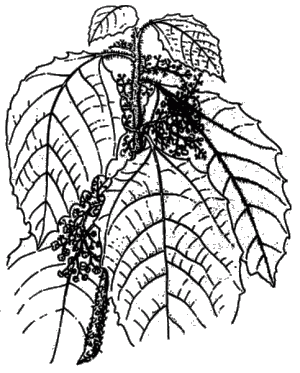m tall with elongated leaves which resemble those of the Mango tree.
Gympie

Dendrocnide moroides

Occurrence: Queensland and East coast of Australia, from Cape York in the north to Victoria in the south. Along tracks, along the banks of creeks, and in rain forests.
Description: Tree up to 5 m tall with stinging hairs on leaves, young branches, and fruits. Fruits are edible.
Effects: Mechanical-chemical through stinging hairs. This is reported to be the most painful of all stinging trees. The stinging hairs break off when touched and inject a poison into the skin. Immediate burning sensation and itching will follow, including reddening and blistering. The burning can last for weeks. People can suffer even if they don't touch the plant. These trees continuously shed their stinging hairs. Staying close to a stinging tree for more than an hour can cause painful and continuous bouts of sneezing.
Measures: Tetanus prophylaxis, corticosteroid ointment, medical attention.
Reference: Kruszelnicki
Similar plants: 36 other Dendrocnide species, all with nettle hairs, in the Pacific region, including Dendrocnide corallodesme in Queensland, Australia, and New Guinea, in rain forests, growing 6 m tall with elongated leaves which resemble those of the Mango tree.
Nilgiri Nettle Dcne.

Girardinia leschenaultiana

Occurrence: India, China, South-East Asia. Forest margins, along streams, altitude 1500-2800 m.
Description: Perennial herb, elliptic leaves, lobed or serrate, inflorescences 5-10 cm.
Effects: Mechanical-chemical by stinging hairs. After touching the plant burninging sensation and itching can occur, later reddening of the skin and perhaps blistering.
Measures: Corticosteroid ointment, medical attention, Tetanus prophylaxis.
Reference: Behl; Flora of China
Wood Nettle

Laportea canadensis

Occurrence: North America from Canada to Florida. Frequentlyfound in low forests and on riverbanks. The plant prefers grounds rich in nutrient.
Description: Up to 1.10 m high shrub with greenish blossoms, flowering from June to September. Parts above the ground are covered with stinging hairs. In contrast to the Stinging Nettle, leaves are alternate.
Effects: Mechanical-chemical through stinging hairs. After touching the plant burning and itching may occur, including reddening of the skin and perhaps blistering. Young leaves are edible when cooked.
Measures: Usually none. Sap from Impatiens or Rumex species can alleviate the effect. In more severe cases apply corticosteroid ointment, search medical attention, get Tetanus prophylaxis.
Reference: Peterson
Tree Nettle

Laportea spp.

Synonyms: Fever Nettle (en)
Occurrence: Frequently found in subtropical and tropical regions in Europe, Asia, and Australia. Also in secondary forests and thickets.
Description: Shrub or small tree with inconspicuous white or greenish blossoms. Leaves are covered with stinging hairs, mostly also leaf stalks and other parts.
Effects: Strong mechanical-chemical skin irritation by stinging hairs. After slightly touching the plant severe burning sensation or itching can occur. Later skin reddening and often blistering. Sleeplessness and fever can occur when large areas of the skin are affected.
Measures: Bath affected skin areas in soap solution. Corticosteroid ointment, medical attention, Tetanus prophylaxis.
Reference: Merrill (1)
Nettle Tree

Urera baccifera
Synonyms: Ortiga (es), Chichicaste (es)

Occurrence: In tropical America frequently found at low and middle altitudes. Sometimes cultivated as hedge plants.
Description: Small bush, shrub or tree, covered with stinging hairs.
Effects: Severe mechanical-chemical skin irritation through stinging hairs. After slightly touching burninging sensation and itching. Later reddening and often blistering. Sleeplessness and fever can occur when extensive areas of the skin are affected. If leaves streak the body, this can already cause severe pain which can last for 24 hours.
Measures: Bath affected skin areas in a soap solution. Corticosteroid ointment, medical

